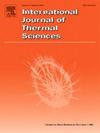Numerical research of a new pipe network cooling scheme without film holes for the gas turbine blade mid-chord region
IF 4.9
2区 工程技术
Q1 ENGINEERING, MECHANICAL
International Journal of Thermal Sciences
Pub Date : 2025-03-15
DOI:10.1016/j.ijthermalsci.2025.109860
引用次数: 0
Abstract
To explore new efficient cooling technology for advanced gas turbine blades and reduce dependence on film cooling, this paper proposes a novel pipe network cooling structure. The design connects leading-edge impingement cooling holes to trailing-edge slits through lateral pipes and incorporates independent vertical pipes to form a network structure. This cooling structure can be applied to a complete blade cooling system, demonstrating strong cooling performance in the mid-chord region despite the absence of film holes, while achieving a more uniform overall temperature distribution, showing promising developmental potential. Through experimental and numerical simulations, comparisons were made with typical gas turbine blade cooling structures and double-wall cooling structures. The results indicate that this new pipes network cooling structure offers superior cooling performance and achieves a more uniform temperature distribution. In addition, the study investigated the impact of lateral pipes shapes and the distances between transverse and vertical pipes relative to the end wall on cooling performance. The results showed that, under the same boundary conditions, hexagonal pipes performed better. The relative positions of transverse and vertical pipes significantly affected blade cooling efficiency. P1/P2 = 0.5, the temperature distribution was the most uniform; P1/P2 = 1, heat transfer in the mid-chord region improved.
燃气轮机叶片中弦区无膜孔新型管网冷却方案的数值研究
为探索先进燃气轮机叶片高效冷却新技术,减少对气膜冷却的依赖,本文提出了一种新型管网冷却结构。该设计通过侧管将前缘撞击冷却孔与尾缘狭缝连接,并合并独立的垂直管,形成网状结构。这种冷却结构可以应用于完整的叶片冷却系统,在没有膜孔的情况下,在中弦区仍具有较强的冷却性能,同时整体温度分布更加均匀,具有很好的发展潜力。通过实验和数值模拟,与典型燃气轮机叶片冷却结构和双壁冷却结构进行了比较。结果表明,这种新型管网冷却结构具有较好的冷却性能和较均匀的温度分布。此外,该研究还研究了侧管形状以及横向和垂直管道相对于端壁的距离对冷却性能的影响。结果表明,在相同的边界条件下,六角形管的性能更好。横向和垂直管道的相对位置对叶片冷却效率有显著影响。P1/P2 = 0.5时,温度分布最均匀;P1/P2 = 1,中弦区换热得到改善。
本文章由计算机程序翻译,如有差异,请以英文原文为准。
求助全文
约1分钟内获得全文
求助全文
来源期刊

International Journal of Thermal Sciences
工程技术-工程:机械
CiteScore
8.10
自引率
11.10%
发文量
531
审稿时长
55 days
期刊介绍:
The International Journal of Thermal Sciences is a journal devoted to the publication of fundamental studies on the physics of transfer processes in general, with an emphasis on thermal aspects and also applied research on various processes, energy systems and the environment. Articles are published in English and French, and are subject to peer review.
The fundamental subjects considered within the scope of the journal are:
* Heat and relevant mass transfer at all scales (nano, micro and macro) and in all types of material (heterogeneous, composites, biological,...) and fluid flow
* Forced, natural or mixed convection in reactive or non-reactive media
* Single or multi–phase fluid flow with or without phase change
* Near–and far–field radiative heat transfer
* Combined modes of heat transfer in complex systems (for example, plasmas, biological, geological,...)
* Multiscale modelling
The applied research topics include:
* Heat exchangers, heat pipes, cooling processes
* Transport phenomena taking place in industrial processes (chemical, food and agricultural, metallurgical, space and aeronautical, automobile industries)
* Nano–and micro–technology for energy, space, biosystems and devices
* Heat transport analysis in advanced systems
* Impact of energy–related processes on environment, and emerging energy systems
The study of thermophysical properties of materials and fluids, thermal measurement techniques, inverse methods, and the developments of experimental methods are within the scope of the International Journal of Thermal Sciences which also covers the modelling, and numerical methods applied to thermal transfer.
 求助内容:
求助内容: 应助结果提醒方式:
应助结果提醒方式:


